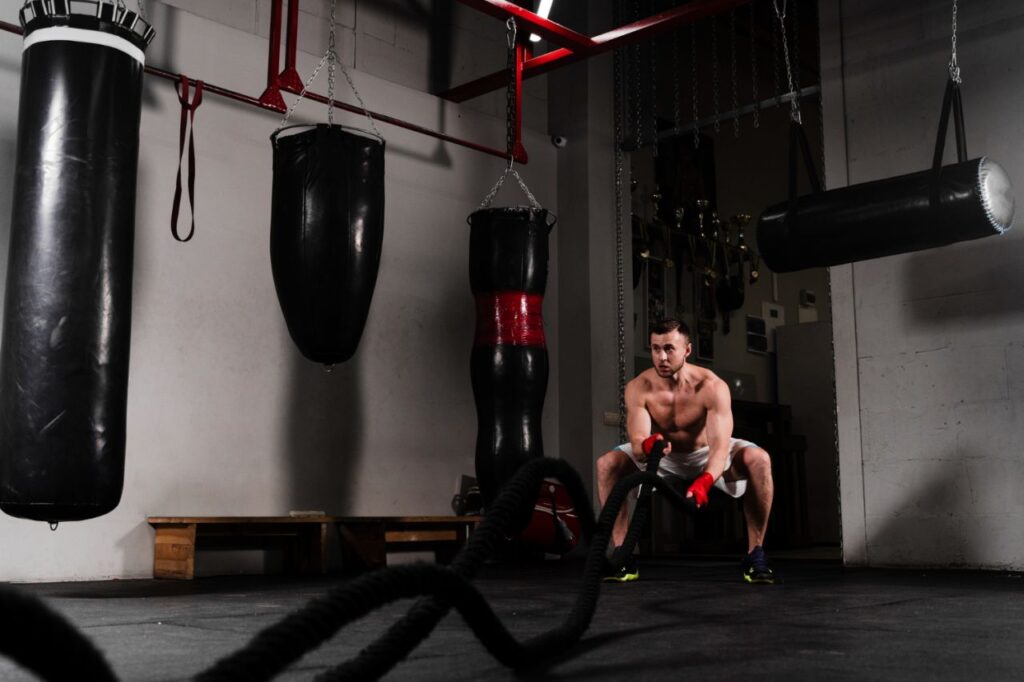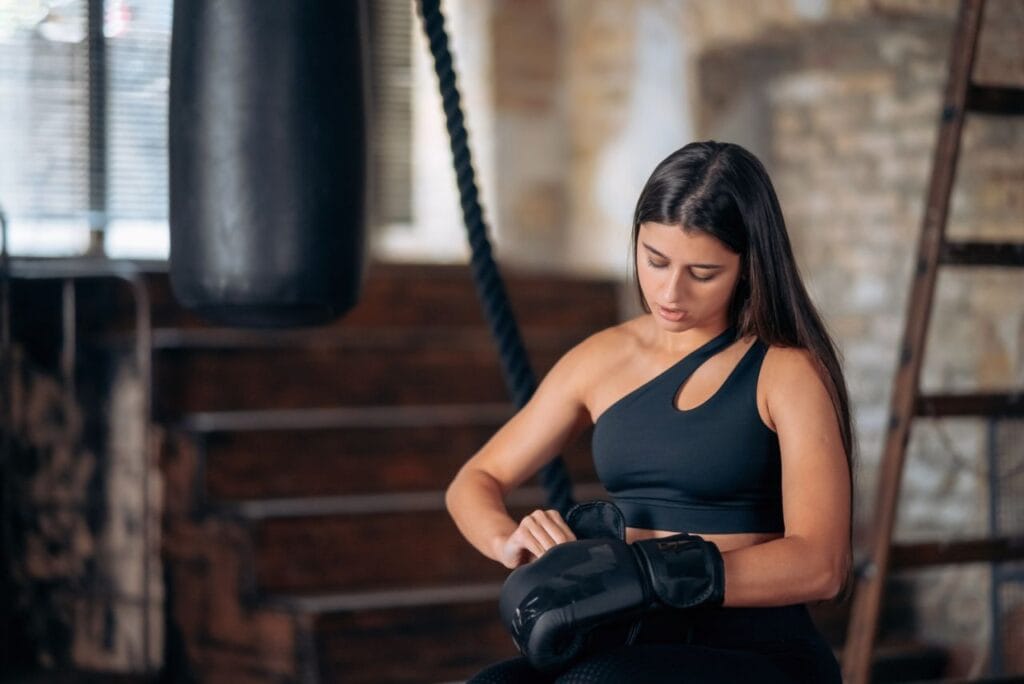Whether you are doing formal training like bag drills or sparring with another boxing enthusiast, your muscles go through these processes all the time. You train hard. You train smart. You leave it all in the gym and on the track.
However, you are starting to question your recovery technique and efforts. As there are no seasons in boxing, you must plan your rest days, but find a way to aid your recovery so you can hit the gym even stronger next time. The last thing you want to happen is to get injured!
Don’t be deceived! Just because you are not getting punched in the face does not mean that you don’t need proper recovery for your body after a fitness boxing class. It takes work to make sure you stay healthy and uninjured in the ring or on the mat.
Recovery is a crucial part of your fitness journey and is just as important as your actual workouts.
Particularly for a high-impact and high-intensity exercise like boxing, being aware of proper recovery habits and routines is key to recovering quicker, being less sore and getting the full benefits from each workout.
It is important to take care of your body for both your long and short term well being.
The human body is made up of about 60 per cent water. There is a good chance that a large percentage of yours is on the floor, towel or soaking your clothes after class. It is crucial to replenish that fluid.
Plain water is always acceptable, and numerous studies have shown a clear correlation between high water consumption and weight loss. Of course, there are a lot of sports drinks available as well to replace electrolytes, but water is generally sufficient as long as you are eating healthy.
It seems like you’re taking too much time to recover from tough workouts. So let’s check out some tips and tricks you can employ to help you bounce back faster from tough boxing training.
Boxing Workout Recovery Tips
After consistent boxing training, have you ever found that it takes your muscles longer for you to recover fully? Boxing is one of the most physically demanding sports on your body, which makes it vital that you have a good recovery process to continue performing efficiently at the highest level.
Training hard is very important to reach your goals physically, but training smart is vital for longevity in a sport that takes no prisoners. So let’s check out some tips and tricks you can employ to help you bounce back faster from tough boxing training.
Warm-Up & Cool Down
Always start your workouts with a warm-up session. You’re about to engage in some high-impact, high-intensity training. You want to give your body a chance to raise heart rate, spread oxygen, and prepare muscles for at or near-maximum capacity training.
Ten minutes on the treadmill is adequate.
Additionally, it would help cool down at the end of each workout with some low-intensity walking. You’ll minimize the muscle strain you face, break up lactic acid stores, and bounce back faster from training as a result.
Stretching
By stretching the main muscles groups pre-workout, you are helping your muscles be flexible, which will help reduce stiffness and the chance of injuries.
Post-workout stretching has been proven in much research to help blood flow and reduce muscle soreness. It’s also important to remember to stretch the muscle groups you will be using each workout.
So in the case of boxing, you want to be stretching the majority of your upper and lower body. You use most of your body for each punch and movement you make, so your shoulders and chest muscles are important to stretch to deliver consistent and powerful punches.
Take Rest Days
Many young boxers enthusiastically enter the gym or the ring each day, training nonstop.
This will feel good for a few days. However, the strain and drain faced by your central nervous system (CNS) will become apparent over time.
The body needs breaks to rebuild its resource stores. This is necessary for long-term viability. Longer-term wear can lead to muscle tissue damage disguised as soreness.
Take a few days to rest every six weeks as well, to allow your CNS several true recovery and repair sessions each year.
Use Foam Rollers
Foam rollers help reduce the stiffness of muscles and increase blood flow to muscles, as many other methods on this list. However, there are many types of foam rollers. For example, some are long, and some are short. Also, the texture type can vary a lot.
In addition to these, foam rollers have different hardness levels.
And you don’t want to start using a foam roller which is too firm as it can cause bruises and even more soreness. So using a really hard roller is counterproductive as we want to relieve sore muscles.
So you need to prefer a softer one, and once you are comfortable with it and it does not hurt too much while using it on your muscles, you can start using a firmer one.
Furthermore, different texture types have different effects on your muscles, which might reduce the soreness even more.
Shortly, choosing gradually harder foam rollers and using ones with different textures can be ideal for optimizing the positive effects.
Record Your Sleep

Most wise boxers keep a journal, recording their training efforts. This allows them to analyze their training later, to see what led to improvements and what left them run down and weaker.
Extremely smart athletes keep a nutritional journal as well, quickly jotting down what they eat each day to remain accountable for nutritional choices and allow for analysis of eating patterns to see what is working and what is not.
Apply this same principle to recovery as well! First, write down what time you fall asleep and what time you wake up. Next, record how many times you wake up each night – this analysis may help limit how often this happens.
Next, write down any naps you take. Then, compare the rest you enjoy with the training results you see in the following days. You’ll likely realize that more accountable sleep equals greater training and recovery productivity.
Take protein supplements
You will need to invest in this, but I highly recommend taking a protein supplement if you plan to do a lot of boxing training. Proteins are the main ingredient in muscle recovery.
Taking this will help speed up your muscle recovery rate as you will be getting key nutrients into your body, rebuilding and repairing your muscles after a hard training session.
This is important for anyone who is boxing consistently in the gym.
You will see a big difference in your performance and recovery by taking protein supplements. It will give you that extra boost, which means performing at the highest level.
Ice Baths Rock!
If your goal is to defeat soreness from training, inflammation is your biggest enemy! Lifting, punching, sparring and running create plenty of micro-tears in your muscle fibres. As a result, lactic acid and cortisol build up.
Apply a cold compress to your trained areas to help bring down this inflammation. It may feel uncomfortable at times.
However, dealing with some delayed onset muscle soreness (DOMS) for a few hours, such beats facing it for a few days! So instead, use ice packs and baths regularly to recover faster from tough workouts.
Cryotherapy
These heal quicker when your muscles and bones are exposed to really cold temperatures. It is similar to putting ice on bruises. However, it is way more effective.
You can choose to apply this therapy to certain body parts like your arms or abs, or you can choose to apply this therapy to all of your body.
However, there is no scientific evidence showing that one helps more than the other. So you can try both of these approaches and see which one works the best for you.
Take a CBD Oil product.
Using CBD oil cream/gel can be a great way to target sore muscles
In terms of a CBD oil product, many of the top CBD brands have some CBD cream/gel to help with muscle aches. This is a great alternative to help with muscle soreness and inflammation.
As someone who is training all the time, the CBD cream has benefited me in my muscular recovery after a hard boxing or gym session.
Your body has its endocannabinoid system, which means it’s one of the most effective ways to quickly absorb through your skin with a CBD cream/gel product.
Sweat!
Fighters increase body temperature for fast recovery by relaxing muscles, blood cells and skin. In addition, spending time in a hot environment increases blood flow to muscles and speeds up your metabolism rate.
Thus these improve the blood flow in muscles and healing of injured tissues.
You can increase your body temperature in so many ways. For example, you can get into a sauna or train in sauna suits that reputable martial arts companies mostly produce.
But, unfortunately, when you wear one, it cuts off the air circulation between your skin and outside. This can make you sweat at a really fast rate.
Massage Gun
Massage guns have recently really become very popular in recent years. However, there is an initial investment you have to make if you are planning on better muscle recovery. It helps to target deep tissue in your muscles by repeatedly moving in and out.
A massage gun also aims to reduce inflammation by flushing extracellular fluids such as lactic acid in the muscle tissue. This is great for boxers as it can quickly reduce muscle soreness, relax tight muscles and ease tension.
However, sauna suits may bother you while throwing punch combinations working out with a heavy bag, and you may not want to wear one while doing these, and it is understandable. However, wearing one for running would not be an issue for most people.
Hydration
Drinking lots of water and keeping hydrated is essential for anyone who wants to stay fit and healthy. In terms of recovery and keeping well hydrated, it will mean better muscle recovery. You will become stronger first by breaking down and then rebuilding through protein synthesis by exercising your muscles.
This, however, requires that the muscles are hydrated first. If you are too dehydrated after, the protein synthesis will slow down, and therefore your recovery after your boxing training will take longer.
Go to a Massage Center
Many recovery methods’ principle, including massage, is the same. Improve the oxygen and blood circulation in muscle cells so soreness in muscles can be treated faster.
Also, your muscles might have poor circulation because of some unknown reason, and this can cause more aches and soreness. However, regular massages can help to solve this issue as well.
In addition to these, after tough boxing drills, lactic acid can build up in your muscles, and this may result in muscle spasms.
Massaging can provide more oxygen to muscle cells, and it can provide muscles to get rid of lactic acid so you can have a deep sleep without waking up to leg cramps at night!
Do You Have A Good Nutrition Plan After Every Boxing Workout?
Boxers need to consume enough macronutrients, protein, carbohydrates, and fats, to perform well during training as these affect the energy levels and recovery duration. If a body gets all the micronutrients it needs, the recovery period will be shorter.
With that being said, we don’t do the same training every day. For example, we practice step-drag maneuvers on Monday, and the next day we may try to get better at the pivoting foot.
So, everyday calorie expenditure and many other factors, which can change the macronutrients ratio and quantity, may differ. Therefore, a boxer needs to determine the diet plan according to the training.
Eating the right foods is not only important for body composition and weight loss; it can also help to minimize injuries and recovery time. The body needs adequate protein, carbs and fats to function at peak performance.
In addition, proteins such as amino acids are the building blocks for the cells responsible for repairing damaged tissue.
Without these, the body won’t recover and develop.
Your diet is heavily dependent upon your goals. Of course, a diet consisting of fast food and cake will not leave you in the same physical condition as chicken, broccoli and Greek yogurt. You have to find the balance that is right for you.
The Importance Of Recovery After A Boxing Workout
Can you honestly say that you take some extra time for stretching or active recovery after every workout or class? Proper recovery after any physical activity is important for many reasons as it allows time for muscle healing and repair, improved performance, and reduced risk of injury.
An important habit to form first when you wake up is getting nutrients in your body. People often neglect to have breakfast which can throw your body’s natural and productive rhythm off.
Consuming something as simple as a protein shake with glutamine and amino acids can help reduce muscle soreness and provide the initial nutrients needed to build and develop your muscles.
Similarly, it is important to consume some source of protein within 30 minutes after your workout to make sure your workout is fully optimized.
If you are experiencing an uncomfortable amount of muscle soreness following your workout, a hot tub is very effective in relaxing the muscles. Any heat therapy helps increase blood flow, eliminate stiffness, and quicken the recovery process.
Alternating heat and cold therapy is also an effective way to eliminate inflammation caused by heavy exercise. More advanced cold therapy options such as cryotherapy can help quicken your body’s recovery process if it is available to you, as well.
Things to avoid

Now you must avoid these things after your boxing training. These are fairly obvious but are the worst thing you can do otherwise, and they will affect your recovery potential.
All of these can reduce the chance of replenishing glycogen in the muscles and reducing protein synthesis to get maximum recovery.
- Eating Fatty Foods
- Alcohol
- Smoking
Conclusion
Taking a day to let your body fully recover is harder to do than you think if you enjoy what you are doing. Don’t worry, the fitness boxing gym will be there tomorrow. There is no one-size-fits-all approach to how many or what kinds of recovery days are necessary. Some coaches may promote an “active recovery” day, which means going for a jog or easy swim instead of going to class. Others will say complete rest is necessary. Factors such as age and fitness level play a part in finding the right balance. The best thing you can do is listen to your body.
FAQs
What Helps Sore Muscles After Boxing?
Follow the warm-up with ten minutes of stretching (see our benefits of stretching article for more information).
Be sure to hydrate before and after by drinking sufficient water. Diet is also important; your muscles need fuel, so eat a high carbohydrate, low-fat diet to nourish the body in sufficient time before exercise.
Why Do Boxers Get So Tired After A Boxing Match?
Endurance is a bigger factor in boxing than most other sports because of the psychological factor. Fighting can make you nervous and feel tired faster than you. Getting in shape is the easy part. Being in excellent shape is only the bare minimum standard of being a boxer.
Why Do Arms Hurt After Boxing?
If you’re continuously performing punching motions or bending and flexing the arm repetitively or even the wrists or fingers, these repetitive movements can all be contributing factors to your forearm pain. Boxers may experience forearm pain due to the repetition of punching the punch bags.
How Long Do Boxers Rest After A Boxing Fight?
The body will be exhausted from the intense training leading up to a fight and the fight itself. A boxer should get at least 8 hours for several nights following a fight, and sleep at night isn’t enough.
Should You Eat After Boxing Workout?
After a boxing workout, your body needs to recuperate and replenish those lost nutrients. Boxers know that the proper post-workout meal will help their bodies recover faster and strengthen their muscles. Boxers will eat around 25-30 grams of protein within an hour after a fight to kickstart this process.
- Find a gym. Boxing gyms aren't typically found in the yellow pages, but there are resources on the internet that can lead you in the right direction. ...
- Be sure the gym is within striking distance. ...
- Be open-minded. ...
- Choose your coach carefully. ...
- Do judge the gym by its cover.
So, can boxing be self-taught? Boxing can be self-taught but it's not the quickest and most effective way to become better at the sport because you aren't able to tap into the knowledge of a boxing coach who would be able to help you one to one.
Best Age to Start
Specialists in sports medicine believe that boxing classes are better to start from 9-10 years. Starting too early could result in putting the student off, as boxing is hard work and not always as fun as team sports, such as football or rugby.

